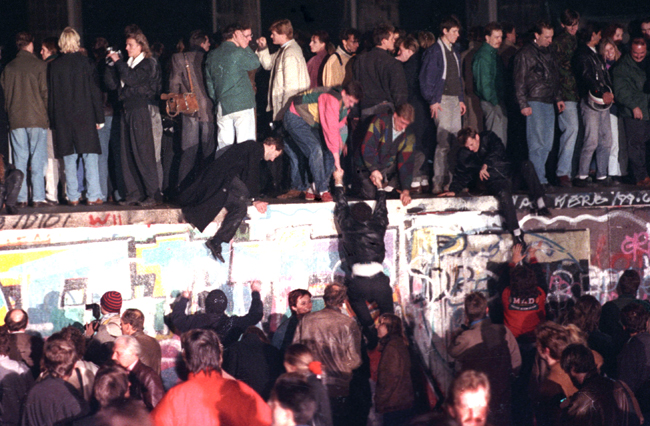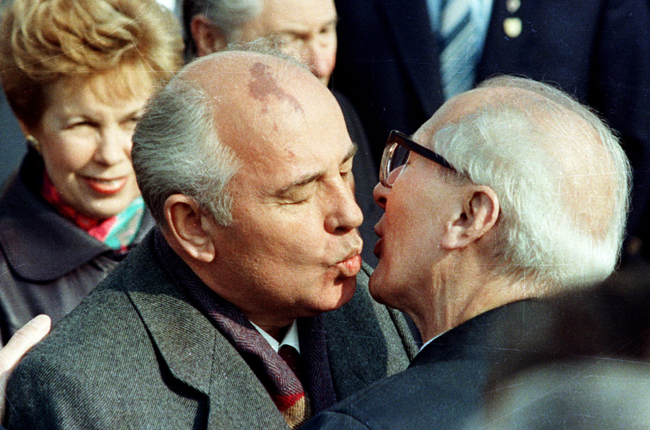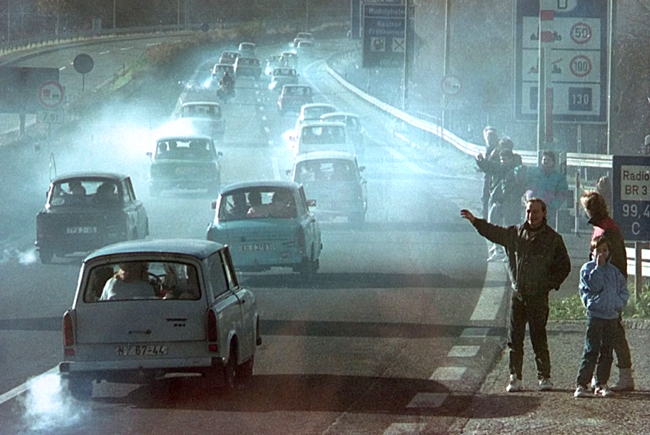Politics
The Day The Wall came tumbling down

Today, 9 November, is the 20th anniversary of the day the Berlin Wall was torn down by the city's own citizens, setting in motion a seemingly inevitable chain reaction that brought an end to the Cold War, finished off the Soviet empire in Central Europe, then the Soviet system and ultimately the Soviet Union itself.
Before it inevitably imploded, for 40 years, that same system had seemed immutable to change. It was woven into the very fabric of our daily lives and our existence. It felt very personal to me. I grew up in the US in the 1950s and 60s and the Cold War was part of everyday life, constantly being referred to in newspapers, on television news and even in entertainment programmes such as “The Twilight Zone”.
In primary school, I can still remember clearly how we carried out those bizarre duck-and-cover exercises where we dropped down onto the floor beneath our school desks, covered our eyes with our hands, and then waited until the teacher could tell us the atomic air raid (or just the drill) was over – and we had survived the blast. Then, trembling, but serenely, we would return to our seats, resume memorising the five-times table or practicing reading.
In the midst of this tense nuclear standoff between the US and the USSR, in 1961 the Russians – well, really the East Germans – began turning a line on a city map into a physical boundary to prevent East Germany’s population from boarding a subway train or taking a long walk to West Berlin and achieving liberation. The wall was a desperate effort to staunch the flow of East Germans out of the “workers’ paradise”.

Photo: Soviet Leader Mikhail Gorbachev and his wife, Raisa, are welcomed by East German Leader Erich Honecker (R) with a fraternal kiss in East Berlin after the Gorbachev’s arrive to celebrate the 40th anniversary of East Berlin, October 6, 1989. REUTERS
Berlin was an anomaly, a leftover from the end of World War II and the beginning of the Cold War. It was still, technically at least, governed by the four victorious major powers from that earlier hot war. The UK, the US, France and the Soviet Union each had their separate sectors – carried over from the defeat of Nazi Germany in 1945. The Russians’ Berlin blockade of 1948-49 was an effort to drive the western nations out of Berlin, the chicken bone in the throat as Nikita Khruschev later called it. The western airlift (including flights by some South African pilots) represented a non-shooting response by the western allies to the blockade. This standoff brought the hardening of the post-war occupation into such a firm division of Germany that it effectively led to two separate nations.
By 1962, the year after the Berlin Wall made it clear the division of the world into American and Russian spheres was here to stay, and in a world where the Americans were increasingly terrorised by the possibility of an actual and apocalyptic end of days, the Cuban Missile Crisis made it seem that a nuclear war was terrifyingly close. And yet, the division in Europe, “from Stettin in the Baltic to Trieste in the Adriatic” as Winston Churchill had put it so crisply in Fulton, Missouri, so many years earlier, continued as it had before. An entire industry of political scientists, nuclear strategists, game theorists and geo-politicians lived out fruitful, full careers explaining how the East-West balance lent stability to the world, how the USSR and the USA were ultimately to be convergent societies, and how the nuclear balance – mutually assured destruction and deterrence, or MADD, I kid you not – would keep the 20th century’s version of Europe’s long peace.
The various attempts at rebellion and revolt in Eastern Europe: East Germany in 1953; Hungary in 1956; Czechoslovakia in 1968; Poland in the 1980s, all seemed to prove one thing, that the division between the two sides was a crucial element in the protection of stability. Any efforts to alter that status quo would add uncertainty and risk. For political figures on both sides of the line, it seemed that the continuing division of Europe was preferable to the encouragement of a wholesale switch of allegiances and an uncertain – even violent – redrawing of the European map.
But deep within Polish society, the Catholic Church, Pope John Paul II, Lech Walesa and his colleagues in the Solidarity trade union in the city of Gdansk began to offer a home-grown alternative. Shortwave radio and television broadcasts from the west to the east, and an increasingly obvious reality that the centralised economy and political system could never provide the kinds of rewards and challenges a new generation of people wanted, all contributed to melting away the foundations of the eastern stasis.
In East Germany, some churches and a few other institutions not totally controlled by the state, became havens for the disaffected to discuss and to think about a different kind of future. Gorbachev’s Soviet experiments with perestroika and glasnost encouraged them further. The seeming success of the new Polish resistance added impetus. The clarity that came from the realisation that the gerontocracy that ran the east could not reform without committing suicide made a way forward increasingly clear.
Then, in the summer of 1989, a growing wave of East Germans piled into their smoky, underpowered skedonks, their Trabants, and drove to Hungary ostensibly for vacations. But Hungary was a way station en route to Austria. Hungarian border guards failed to stop them. Egon Krenz’s East German government could not exercise the discipline to stop the migration. As summer shifted to autumn, on the night of 8 November 1989, Gunter Schabowski, the East German government spokesman, groggy from lack of sleep and operating under increasingly confusing instructions, told a press conference that East Germans could travel “without meeting special provisions” and that the border would be opened after new regulations were promulgated. Asked how long that would take, he said, “immediately”.

Photo: More than 10,000 Free German Youth members march in this file photo of October 6, 1989 in a torchlight parade past the Opera house to celebrate the 40th anniversary of East Germany. REUTERS
The people of East Berlin (and then those in the western sector as well) moved spontaneously to the crossing points in the wall, the border guards decided it was just easier to open the gates than to shoot their compatriots. Thousands of people made their move – and then they started to tear down the wall itself with any tool they could find or even with their bare hands. A month later, on television, we could watch Leonard Bernstein conducting Beethoven’s Ninth Symphony live from Berlin, with the Brandenburg Gate as backdrop to Schiller’s “Ode to Joy”.
New York Times columnist Roger Cohen recently wrote about meeting the actual border guard who opened that fateful gate. Harald Jaeger is retired now, at 66 he tends his vegetable garden. Jaeger explained, “to put it in a nutshell, it was a lucky moment”, around 11pm Jaeger gave the order to open the gates. “Sweat was pouring down my neck and my legs were trembling. I knew what I had done. I knew it immediately. That’s it, I thought, East Germany is finished.”
But Cohen reminds us of another very different moment, earlier that same year. It had been near Beijing’s Tiananmen Square, and we all recall the famous picture of the unknown – unknowable – man, his back to the camera, carrying two shopping bags, standing in front of a line of tanks on their way to crush the freedom movement that had briefly flourished in the square. Think for a moment, what would have happened if the driver of that first tank had taken Jaeger’s choice? What if that driver had had his own “Storming of the Winter Palace” moment and had decided his fate lay with the unarmed people in front of him – instead of the old men in uniform behind him?

Photo: East German Trabant cars make their way past East Germans who have crossed the former border checkpoint Rudolphstein in Bavaria on motorway A9 after the opening of the East German border was announced in this November 11, 1989. REUTERS
Would we now be celebrating China’s great change – as well as Berlin’s, East Germany’s, Eastern Europe’s and the Soviet Union’s? Jaeger, the faceless man and the unknown tank driver converge to inform us how political and social upheavals can be terrifyingly contingent on the nature of a single human choice, in an instant, at the moment of decision.
Here in South Africa, of course, another authoritarian regime made its own U-turn when its leadership watched on television as events unfolded in Eastern Europe. First, a few elderly ANC leaders were let out of jail at the end of 1989 to test the waters, then repressed political parties unbanned, and then, finally, the most famous prisoner of all walked out into the sunlight to join in the negotiations that would tear down some intangible, but very real walls here.
It is said that Josef Stalin, upon hearing that the Pope had decried some religious persecution being carried out by some of Stalin’s henchmen, turned to an aide and said with a sneer, “So, tell me, how many divisions does the Pope have?” The answer, of course, is, as with the East Germans in Berlin, sometimes ideas matter a great deal.
By Brooks Spector
WATCH: Berlin Wall 1961 – 1989
Main photo: West Berlin citizens continue their vigil atop the Berlin Wall in front of the Brandenburg Gate, November 10, 1989. Thousands of people rallied on the dividing border. REUTERS





 Become an Insider
Become an Insider